Introduction
Both artificial intelligence and machine learning have advanced significantly since its founding in the late 1950s. In recent years, these technologies have become increasingly sophisticated and complex. Though praiseworthy, technical developments in the field of data science have led to an overabundance of jargon that is incomprehensible to the general public.
In the ever-evolving landscape of artificial intelligence, two terms that often dominate discussions are “Deep Learning” and “Neural Networks.” As technology advances, it becomes imperative to understand the nuances of these concepts to appreciate their role in shaping the future. In this blog, we delve into the intricacies of deep learning and neural networks, exploring their definitions, workings, architectures, and structures. By the end, you’ll have a comprehensive understanding of the importance of these technologies and how they differ.
What is Deep Learning?
Artificial intelligence (AI) is at its bleeding edge, and deep learning reflects that. With deep learning, a computer trains itself to process and learn from data, as opposed to machine learning, which teaches computers how to do so.
ANNs in layers make all of this possible. Recall that I mentioned there are only three layers in the most basic form of an ANN? Deep learning is based on an ANN known as a “deep neural network,” which is composed of more than three layers, such as an input layer, an output layer, and numerous hidden layers. Like people, a deep learning system learns by doing—sorting through information through several levels of concealment.
Deep learning is a subset of machine learning, which is itself a subset of artificial intelligence. At its core, deep learning involves training artificial neural networks on vast amounts of data to enable them to make decisions or predictions without explicit programming. The “deep” in deep learning refers to the multiple layers through which data is transformed as it passes through the neural network.
Deep Learning System
A deep learning system or deep neural network is a neural network that has several hidden layers and several nodes in each hidden layer. The creation of deep learning algorithms that may be applied to complex data to train and anticipate results is known as deep learning.
In Deep Learning, “deep” refers to the depth, or number of hidden layers, in the neural network. In essence, a deep learning model is any neural network that has more than three layers—that is, the input and output layers included.
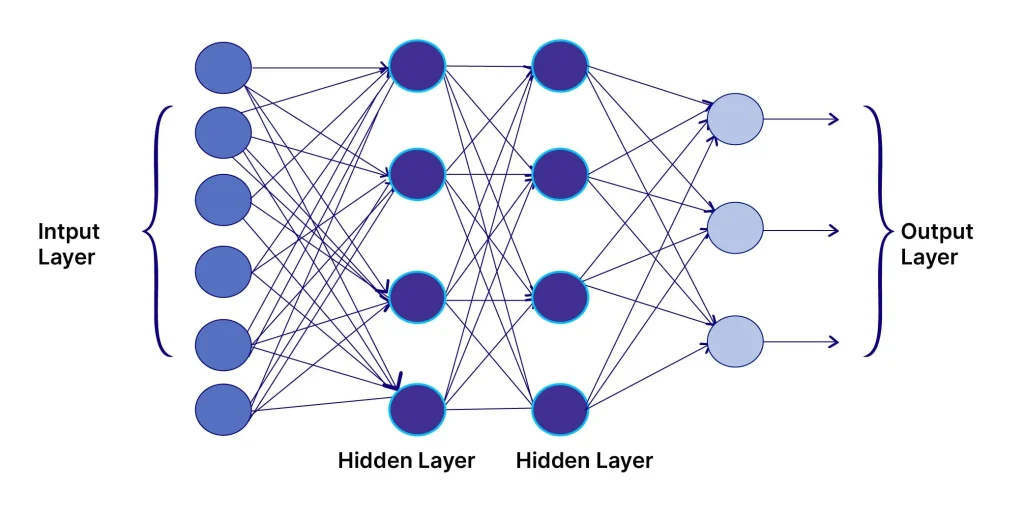
How does Deep Learning Work?
Deep learning models learn from data through a process known as training. The model is fed large datasets, and it learns to identify patterns and features by adjusting its parameters. The learning process is iterative, with the model continuously refining its understanding through backpropagation, where errors are propagated backward to update the model’s parameters. This allows the model to make increasingly accurate predictions as it encounters more data.
Examples of a Neural Network for Deep Learning
The following are five examples of how neural networks can be used for deep learning:
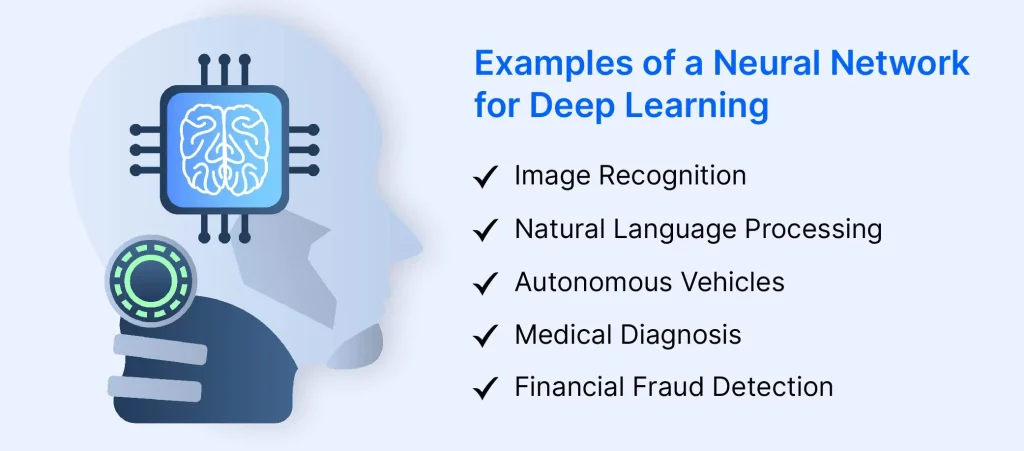
1. Image Recognition
A neural network for deep learning excels in identifying and classifying objects within images, enabling applications like facial recognition, object detection, and automated image tagging.
2. Natural Language Processing
Neural networks are employed for language understanding, enabling tasks such as sentiment analysis, language translation, and chatbot interactions, where the model interprets and generates human-like text.
3. Autonomous Vehicles
In the realm of self-driving cars, neural networks are crucial for processing sensor data, recognizing road signs, pedestrians, and other vehicles, and making real-time decisions for navigation and control.
4. Medical Diagnosis
Neural networks contribute to medical advancements by analyzing complex data such as medical images, patient records, and genomic data, assisting in the diagnosis of diseases, and the identification of potential treatments.
5. Financial Fraud Detection
Neural networks play a vital role in the finance sector for fraud detection as it analyzes patterns and anomalies in the transaction data, thus providing a robust defense against financial cyber threats.
Deep Learning Model Architectures
Deep learning models come in various architectures, each designed for specific tasks. Some common architectures include:
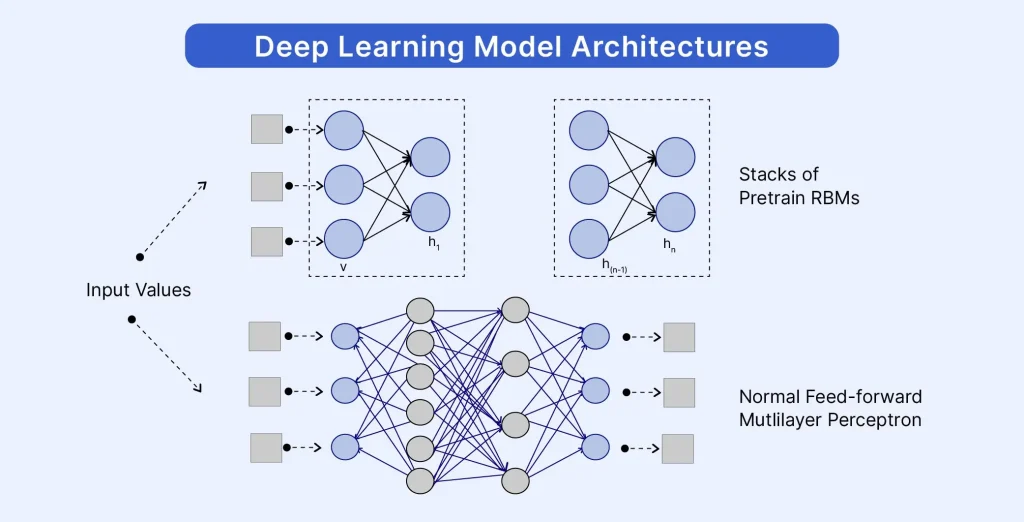
Feedforward Neural Networks (FNN): The simplest form of deep learning, where data travels in one direction through the network without cycles or loops.
Convolutional Neural Networks (CNN): Optimized for image processing, CNNs use convolutional layers to identify spatial hierarchies of features.
Recurrent Neural Networks (RNN): Suitable for sequential data, RNNs maintain a memory of previous inputs, making them effective for tasks like natural language processing.
Generative Adversarial Networks (GAN): Comprising a generator and a discriminator, GANs are used for generating new data that is indistinguishable from real data.
Deep Learning Model Structures
Deep learning model structures represent the architectural framework that enables the powerful capabilities of neural networks in solving complex problems. These structures consist of interconnected layers of artificial neurons, inspired by the intricate web of neurons in the human brain. The fundamental building blocks include the input layer, hidden layers, and output layer. The input layer receives raw data, which is then processed through hidden layers, each containing multiple neurons with unique weights and activation functions. The final output layer produces the model’s prediction or classification.
Deep learning models often feature deep neural networks, characterized by multiple hidden layers, allowing them to learn hierarchical representations of data. Convolutional Neural Networks (CNNs) excel in image-related tasks by leveraging convolutional layers, while Recurrent Neural Networks (RNNs) are adept at handling sequential data, such as natural language.
These structures enable deep learning models to automatically learn intricate patterns and features from vast datasets, making them highly adaptable to diverse applications. The deep learning revolution has been driven by the flexibility and scalability of these model structures, empowering advancements in image and speech recognition, natural language processing, and various other domains. As researchers and practitioners continue to innovate, the exploration and refinement of deep learning model structures remain at the forefront of artificial intelligence development. Notable structures include:
- Sequential Structure
- Functional Structure
- Custom Structure
What is a Neural Network?
A neural network is a computational model inspired by the structure and functioning of the human brain. It is a fundamental component of machine learning and artificial intelligence. Neural networks consist of interconnected nodes, also known as neurons or units, organized into layers. These layers include the input layer, hidden layers, and output layer.
Input Layer: The first layer receives the raw input data, which could be features extracted from images, text, or other sources.
Hidden Layers: Intermediate layers between the input and output layers where complex computations take place. Each node in a hidden layer processes information and passes it to the next layer.
Output Layer: The final layer produces the network’s prediction or output based on the processed information.
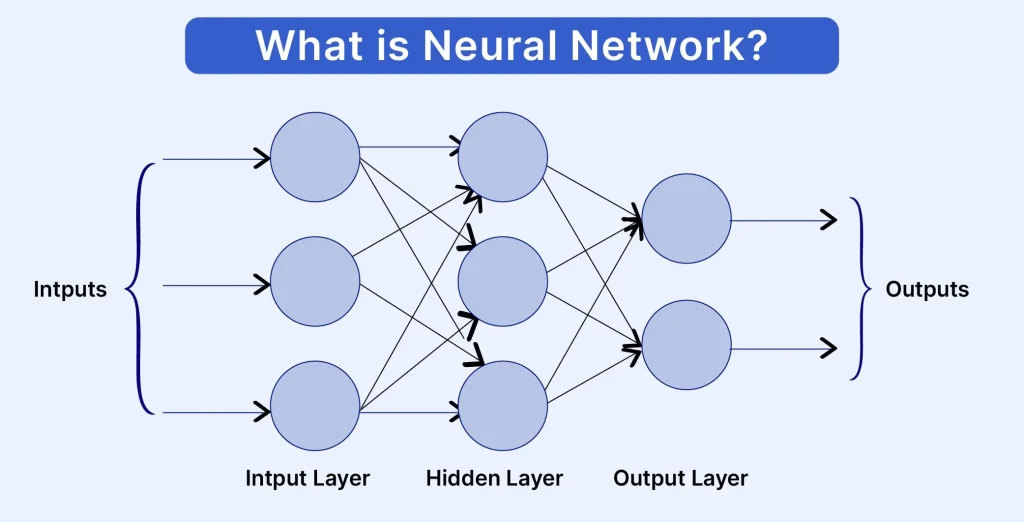
The connections between nodes have associated weights that the network adjusts during training. An activation function is applied to each node, introducing non-linearity and allowing the network to capture complex patterns.
Neural networks learn by adjusting these weights based on the difference between their predictions and the actual outcomes in training data. This learning process, known as backpropagation, is iterative and aims to minimize the error in predictions.
How does Neural Networks Work?
Neural networks work by processing information through interconnected layers of nodes. The input layer receives raw data, which is then passed through the hidden layers. Each connection in the network has an associated weight, and the model adjusts these weights during training to minimize errors in predictions. The output layer produces the final result or prediction based on the learned patterns.
Neural networks consist of layers of interconnected nodes. There are typically three types of layers: input layer, hidden layers, and output layer.
Input Layer: Receives input data, representing features or attributes of the problem.
Hidden Layers: Intermediate layers between input and output. Each node in a hidden layer processes information and passes it to the next layer.
Output Layer: Produces the final result or prediction based on the input and the network’s learned patterns.
Neural Network Architectures
Neural networks come in various architectures to suit different tasks:
Single-Layer Perceptron (SLP): The simplest form of a neural network, with one layer of input nodes directly connected to the output layer.
Multi-Layer Perceptron (MLP): Contains one or more hidden layers between the input and output layers, enabling the model to learn more complex patterns.
Radial Basis Function Networks (RBFN): Utilize radial basis functions as activation functions, making them effective for pattern recognition.
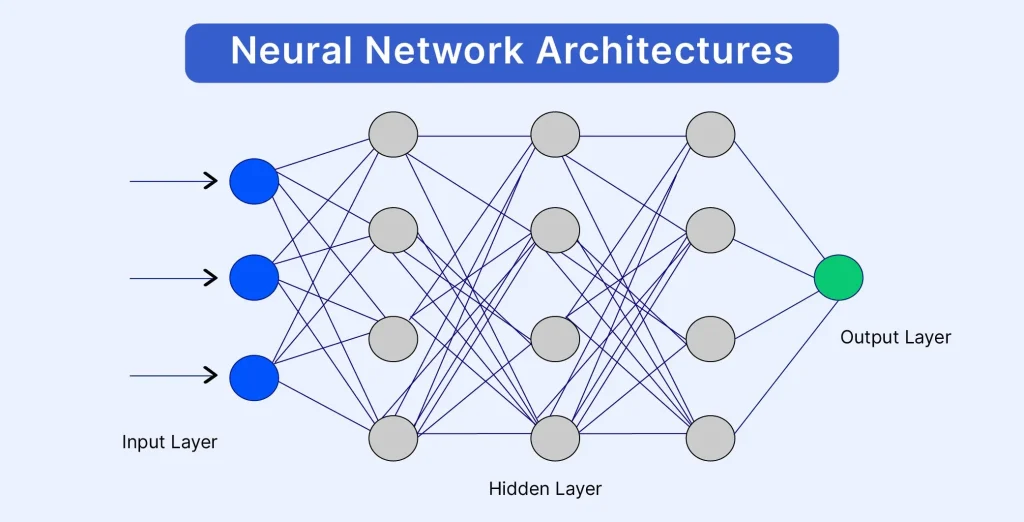
Neural Network Structures
Neural network structures define how the layers and nodes are organized within the model:
Feedforward Networks: Information flows in one direction, from input to output, without loops or cycles.
Recurrent Networks: Allow for feedback loops, enabling the network to maintain memory of previous inputs.
Modular Networks: Comprise multiple interconnected sub-networks, each handling a specific aspect of the task.
What is the Importance of Deep Learning and Neural Networks?
The significance of deep learning and neural networks lies in their ability to handle complex tasks and learn intricate patterns from vast amounts of data. Some key areas of importance include:
Deep learning excels at recognizing complex patterns, making it invaluable in image and speech recognition. Neural networks are crucial for understanding and generating human-like language, powering applications like chatbots and language translation. Both deep learning and neural networks are extensively used in predictive modeling, forecasting trends, and making data-driven decisions. Deep learning, particularly CNNs, has revolutionized computer vision by enabling machines to understand and interpret visual data. Furthermore, many companies are providing modern NLP services, enabling businesses to harness the power of natural language processing for enhanced communication and data analysis.
Deep Learning vs Neural Networks
While deep learning is a broader concept that encompasses neural networks, it’s essential to distinguish between the two:
Depth of Architecture: Deep learning emphasizes the use of deep neural networks with multiple layers, enabling more sophisticated feature learning.
Scope of Applications: Neural networks, being the basic units, find applications in various fields, while deep learning, with its complex architectures, is particularly suited for tasks requiring high-level feature representation.
Training Complexity: Deep learning models generally require more computational resources and data for training compared to traditional neural networks.
Flexibility: Neural networks offer more flexibility in terms of architecture, making them suitable for a wide range of tasks, whereas deep learning models are often task-specific.
Conclusion
It’s challenging to distinguish Deep Learning from Neural Networks on the surface due to their tight relationship. But you’ve undoubtedly already realized that deep learning and neural networks are not quite the same.
While Neural Networks use neurons to transmit data in the form of input to get output with the help of the various connections, Deep Learning is associated with the transformation and extraction of features that attempt to establish a relationship between stimuli and associated neural responses present in the brain. Our firm offers top-notch AI development services, delivering innovative solutions tailored to meet the evolving needs of businesses seeking to leverage artificial intelligence for transformative growth and efficiency.
Transform your Business with Our AI Development Services!
Follow IntellicoWorks for more insights!


